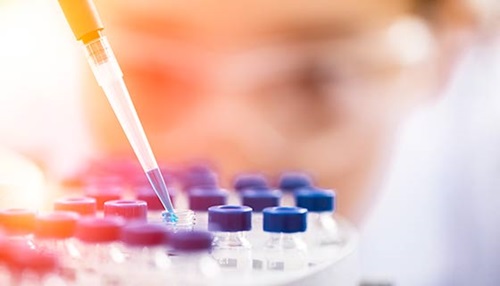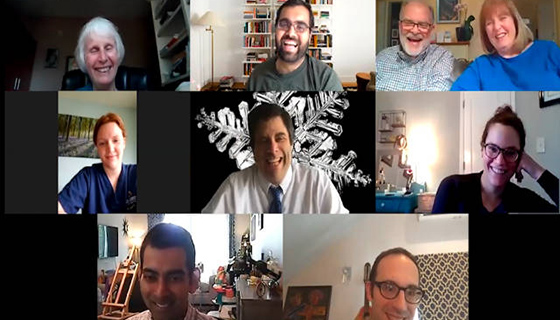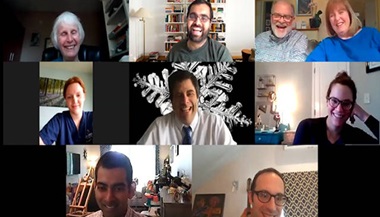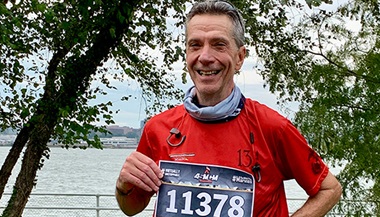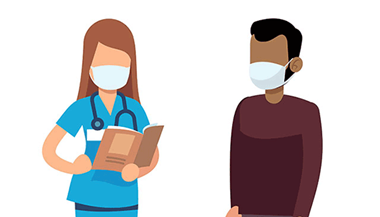Patient Story
Getting Strong Again After COVID-19: Ahmad's Story
Ahmad Ayyad, 40, was in great shape.
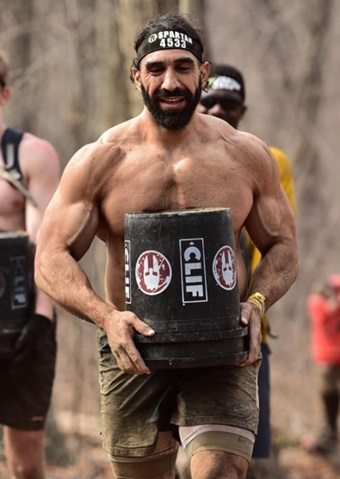
A chiseled 215 pounds on a 6’1” frame, he competed in demanding obstacle course races that had him scrambling over walls and under barbed wire, lugging heavy objects, and traversing monkey bars and rings.
On a typical day, he’d work in his family’s retail furniture business, then box and lift weights, before heading to his Washington, D.C., home. He played basketball several times a week.
And then, COVID-19 almost killed him.
Ayyad was on a ventilator at The Johns Hopkins Hospital for 25 days and lost more than 60 pounds during his ordeal. His doctors say his physical fitness, positive attitude and the support of friends and family are helping him recover from the disease and the toll of long-term ventilation.
Discharged on April 22, Ayyad still has a blood clot in his left arm and damage to his heart and lungs — all complications of COVID-19. But he is gradually putting on weight and has begun running and lifting weights.
“He seems to be making a great recovery,” says Sandra Zaeh, M.D., a pulmonary and critical care medicine fellow, who treated Ayyad in the hospital and continues to care for him as part of a follow-up team called PACT, for Post-Acute COVID Team.
Describing a May 5 video consultation, she says: “It was remarkable to go from seeing him at his sickest in the ICU — intubated, deeply sedated and on his stomach to help him breathe — to seeing him at home. He was smiling and talking about how happy he was to go for a short jog and sit outside with the sun on his face.”
The COVID-19 pandemic is still too new for researchers to predict with certainty who gets sickest and why. However, many of the hardest-hit patients are older than 65 and have comorbidities, such as obesity or diabetes.
And then there’s Ayyad. “He had no reason why he would be at more risk than anyone else,” says Zaeh. “But there could be factors that we don’t yet fully understand.”
Every day, I’m getting better and better...I’m slowly getting my weight back. I’m eating a lot; I’m taking walks outside.
Ahmad Ayyad
Flu-Like Symptoms
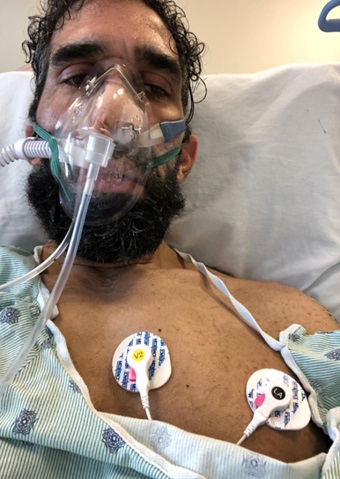
On March 11, Ayyad, the fourth of nine children and the oldest son, began experiencing flu-like symptoms, including a mild fever. Rest and shorbat adas — a lentil soup made by his sister – didn’t help.
By March 14, he was struggling to catch his breath and so weak he couldn’t drive himself to a hospital, says his friend Deena Nasr, a physician assistant at George Washington University Hospital. She convinced him to take an Uber to Sibley Memorial Hospital, which he did the following day.
There, he tested positive for both COVID-19 and influenza A, she says. As his breathing worsened, he was placed on ventilation and transferred that day to The Johns Hopkins Hospital.
Ayyad became the hospital’s third COVID-19 patient and the first to be placed on a ventilator, says Natalie West, M.D., M.H.S., the pulmonary specialist who admitted him.
Unable to speak because of the ventilation tube, he communicated by writing notes, West says. “We had a whole conversation with me talking and him writing,” she says. “The last thing he wrote on that piece of paper was, ‘Thank you so much for taking care of me.’ It brought tears to my eyes. He just seemed like a very sweet and kind person.”
That moment of lucidity was short-lived. For the next 25 days, Ayyad‘s fever rose and fell, his breathing supported by a ventilator. He was heavily sedated and often delirious. He grew agitated and removed his ventilation tube. When the tube was removed a second time to prepare him for a tracheostomy, Ayyad’s breathing proved stable enough that the surgery was not needed.
His recovery had begun.
This is not the flu. People need to be careful and know that it can happen to anybody.
Ahmad Ayyad
Determined to Get Stronger
A few days later, he transferred to a COVID-19 unit in the hospital. Nurses celebrated Ayyad’s remarkable recovery by clapping as he left the ICU in a wheelchair. “Everyone in the ICU was amazing,” he says. “I really feel for them and appreciate everything they do. I hate that caring for me puts them at risk.”
Once out of the ICU, Ayyad focused on gaining weight and strength. “The day I woke up I was 153 pounds,” he says. “My legs and arms were skinny and my chest was gone. I couldn’t believe how hard it was to just get to the edge of the bed and stand.”
Gigi Liu, M.D., M.Sc., a hospitalist and point-of-care ultrasound specialist who tracked Ayyad’s post-ICU progress, describes a patient who was so motivated to get better that he was off nasal oxygen and walking around the hospital room within a few days.
“There’s a certain group that once they’re on a ventilator for a certain period of time, it’s hard to come back,” says Liu. “That wasn’t Ayyad. He happened to be a super-duper fit guy before all this. I think that helped him.”
Also helping were supportive parents who were eager to see him.
“My mom left me a voicemail the day I went into the ICU,” Ayyad says. “It was heartbreaking, her saying, ‘Please call me, let me know you’re doing OK.’ She didn’t believe my dad when he said they couldn’t visit me. She thought he was just trying to protect her from seeing me in a coma.”
Ayyad wanted to move in with his parents when he was discharged, but Liu urged him to self-isolate for two weeks first.
“He asked if he could hug and kiss them after that,” Liu says. “I know he really wanted to, but we don’t know enough yet about this disease and if the virus is still shedding, even though he tested negative twice. I saw the tears in his eyes when I said no. That was the one thing I disappointed him on.”
When Ayyad got to his Washington, D.C., home, his parents were standing on the sidewalk to greet him from a safe distance. They had already filled his refrigerator.
“Every day, I’m getting better and better,” Ayyad said on May 1. “I’m slowly getting my weight back. I’m eating a lot; I’m taking walks outside.”
Ayyad says recovering from COVID-19 is tougher than training for his most difficult races.
“I get the flu every year, and I’m down for two or three days and then I’m better,” he says. “This is not the flu. People need to be careful and know that it can happen to anybody.”
Learn more about COVID-19 and Johns Hopkins on our coronavirus site.
Ahmad's Treatment Team
-
Gigi Liu, MD
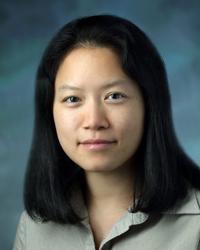
- Director of Point of Care Ultrasound Education, Osler Internal Medicine Residency Program


